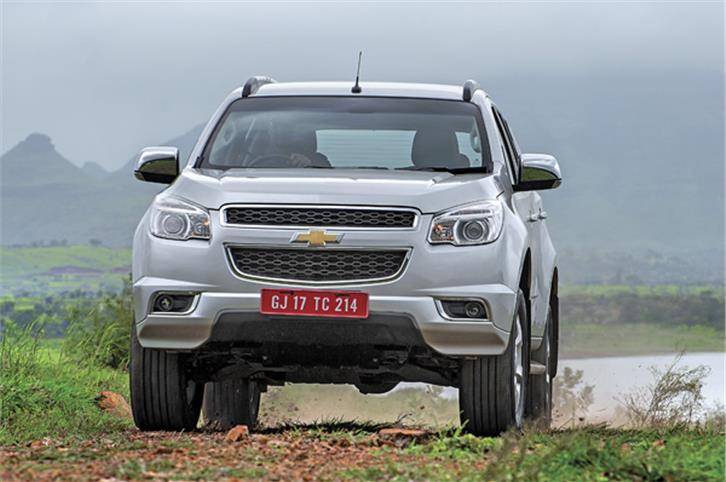Chevrolet Trailblazer review, test drive
Chevrolet wants to draw customers back to its showrooms on the strength of desirable new products. The big Trailblazer SUV is the first of the lot. Does it make an impression?
Published on Sep 18, 2015 04:39:00 PM
95,410 Views
Follow us on



Max attack
The Trailblazer’s engine and the performance it can deliver grabs the limelight the moment we leave behind the rutted tracks and drive on proper tarmac stretches. The engine feels very responsive, the build-up of speed is brisk and performance seems really impressive for a towering SUV that weighs in at a hefty 2,068kg. Against the clock, the Trailblazer’s sub-10 second (9.89 second to be precise) 0-100kph time makes it the quickest SUV of its class. Its quick in-gear timings also help establish the Trailblazer as the performance SUV of the segment. It’s all made possible by the sheer muscle of the Trailblazer’s 2.8-litre Duramax engine. Peak power is a class-leading 197bhp at 3600rpm, but to reiterate, the real number to make note of is the 50.99kgm of torque that’s available at a low 2,000rpm. For reference, the 3.0-litre Fortuner’s engine makes 35kgm at 1,400rpm.
The four-cylinder 2.8-litre Duramax engine used on the Trailblazer is relatively new and was last updated in 2014. It gets double overhead camshafts to operate its 16 valves and also features a water-cooled, variable geometry turbocharger and common-rail injection which operates at high-pressure 2,000bar. There’s a balancer shaft as well to cancel out undue vibrations. Speaking of which, engine refinement on the whole is better than most of the competition. It’s not a particularly quiet motor, especially when revved hard, where the roar of the 7-blade mechanically operated viscous fan can be heard above everything else. At moderate revs, there is a bit of clatter, but it’s not obtrusive in the least. What helps is the automatic gearbox that, on a light throttle, shifts up early and keeps the engine under 2,000rpm as much as possible. The six-speed torque converter automatic is actually cleverly tuned to bring out the best of the engine. Press down hard on the Trailblazer’s long travel throttle pedal and the gearbox will downshift to the right gear quickly enough. Upshifts in full auto mode take place at a fairly low 3,800rpm, but you can take manual control via the gearlever to have the engine rev all the way to 4,800rpm. That the gearbox won’t upshift on its own in manual mode makes it feel pretty much like a manual. It’s fun to hold gear on occasion and the ability to do so is something helpful off-road too. However, power tails off after 4,000rpm, so if it’s quickest acceleration you’re after, you’ll be best off short-shifting at this point. The engine may lack top-end punch, but the ample power in the bottom-end and mid-range more than makes up for it.
On the proper roads we’re on, the Trailblazer also feels more composed in the way it tackles the bumps. There is a degree of vertical movement and large potholes do thud through, but nothing manages to deflect the Trailblazer from its intended path. This gives a good deal of confidence out on the highway. What’s also noteworthy is that the hydraulic power steering is free from that looseness you get in most other SUVs in the segment. It adds to the feeling of control and stability at high speeds. Even around faster bends, the Trailblazer doesn’t feel ill at ease. Sure, there’s plenty of body roll and you can feel the weight transfer from one side to the other, but you still feel very much in control of things. Just wish the brakes were more feelsome. The all-round ventilated discs offer good stopping power, but the brake pedal doesn’t communicate leg force needed well enough. In a way, it’s reassuring to know the Trailblazer comes with anti-lock braking, panic brake assist, electronic brake force distribution, electronic stability control and cornering brake control. Dual front airbags are part of the package as well.
In town and amidst slower moving traffic, the Trailblazer feels its size. The steering’s weight calls for some effort and the turning circle is large too. To be fair, none of its big, burly competitors feel any better. For what it’s worth, frontal visibility is good and there’s a rear-view camera and sensors as well.
Copyright (c) Autocar India. All rights reserved.



Comments
Member Login
Personal Details
No comments yet. Be the first to comment.